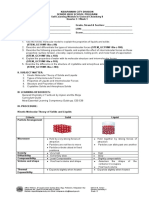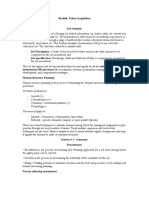Ch11_Lecture
Uploaded by
anyaferre7Ch11_Lecture
Uploaded by
anyaferre7Chapter 11
Liquids and Intermolecular Forces
© 2018 Pearson Education, Inc.
Intermolecular Forces (분자간의 인력)
• The attractions between molecules are not nearly as strong as
the intramolecular attractions (bonds) that hold compounds
together.
• Many physical properties reflect intermolecular forces, like
boiling points(끓는점), melting points(녹는점), viscosity(점도), Intermolecular
surface tension(표면 장력), and capillary action(모세관 현상). Forces
© 2018 Pearson Education, Inc.
States of Matter
• The fundamental difference
between states of matter is
the strength of the
intermolecular forces of
attraction.
• Stronger forces bring
molecules closer together.
• Kinetic energy keeps them
apart and moving.
Remember that average
kinetic energy is related to
temperature!
Intermolecular
Forces
© 2018 Pearson Education, Inc.
Properties and State of Matter
• Solids and liquids are referred to as the condensed
phases(응축상).
Intermolecular
Forces
© 2018 Pearson Education, Inc.
Relative Strength of Attractions
• Intermolecular attractions are weaker than bonds.
• Hydrogen bonds are NOT chemical bonds.
Intermolecular
Forces
© 2018 Pearson Education, Inc.
Types of Intermolecular Force between
Neutral Molecules
• Weakest to strongest forces:
– Dispersion forces (분산력) (or London dispersion forces
or induced dipole-induced dipole interactions)
– Dipole–dipole forces (쌍극자-쌍극자 힘)
– Hydrogen bonding (수소결합, a special dipole–dipole force)
Note: The first two types are also referred to collectively as van
der Waals forces (반데르발스 힘).
Intermolecular
Forces
© 2018 Pearson Education, Inc.
Dispersion Forces
• A nonpolar particle (helium atoms below) can be temporarily
polarized to create dispersion force(분산력).
• The tendency of an electron cloud to distort is called its
polarizability(분극성).
Intermolecular
Forces
© 2018 Pearson Education, Inc.
Factors That Affect Amount of
Dispersion Force in a Molecule
• Number of electrons in an atom (more
electrons, more dispersion force)
• Size of atom or molecule/molecular weight
• Shape of molecules with similar masses
(more compact, less dispersion force)
Intermolecular
Forces
© 2018 Pearson Education, Inc.
Polarizability and Boiling Point
• If something has less intermolecular force (smaller molecule or
atom: lower molecular weight, smaller size, fewer electrons) →
a lower boiling point.
Intermolecular
Forces
© 2018 Pearson Education, Inc.
Dipole–Dipole Interactions
• Polar molecules have a more positive and a more negative
end—a dipole (two poles, δ+ and δ−).
• The oppositely charged ends attract each other.
Intermolecular
Forces
© 2018 Pearson Education, Inc.
Dipole–Dipole Interactions
For molecules of approximately equal mass and size, the more
polar the molecule, the higher its boiling point.
Intermolecular
Forces
© 2018 Pearson Education, Inc.
Which Have a Greater Effect:
Dipole–Dipole Interactions or
Dispersion Forces?
• If two molecules are of comparable size and shape, dipole–
dipole interactions will likely be the dominating force.
• If one molecule is much larger than another, dispersion forces
will likely determine its physical properties.
Intermolecular
Forces
© 2018 Pearson Education, Inc.
What Does This Graph Show Us?
• In a group, the period 3/4/5 elements have higher boiling points
as the group member gets larger.
• What happens with the period 2 elements? For group 4A, the
Intermolecular
trend is continued. Forces
© 2018 Pearson Education, Inc.
Hydrogen Bonding
• The dipole–dipole interactions
experienced when H is
bonded to N, O, or F are unusually
strong.
• We call these interactions hydrogen
bonds.
• A hydrogen bond is an attraction
between a hydrogen atom attached to
a highly electronegative atom and a
nearby small electronegative atom in
another molecule or chemical group.
Intermolecular
Forces
© 2018 Pearson Education, Inc.
What Forms Hydrogen Bonds?
• Hydrogen bonding arises in part from the high electronegativity
of nitrogen, oxygen, and fluorine.
• These atoms interact with a nearly bare hydrogen nucleus
(which contains one proton but NO inner electrons).
Intermolecular
Forces
© 2018 Pearson Education, Inc.
Ice Compared to Liquid Water
• Hydrogen bonding makes the molecules
farther apart in ice than in liquid water.
Intermolecular
Forces
© 2018 Pearson Education, Inc.
Ion–Dipole Interactions
• Ion–dipole interactions are found in
solutions of ions.
• The strength of these forces is what
makes it possible for ionic substances
to dissolve in polar solvents, like water.
Intermolecular
Forces
© 2018 Pearson Education, Inc.
Determining Intermolecular Forces
in a Substance
• Note that ALL chemicals exhibit dispersion forces.
• The strongest force dictates the extent of attractions between
Intermolecular
molecules. Forces
© 2018 Pearson Education, Inc.
Generalizations about Relative
Strengths of Intermolecular Forces
1) When two molecules have
comparable molar masses and
shapes, dispersion forces are
roughly equal.
2) When two molecules have very
different molar masses and there is
no H-bonding, dispersion force
determines the substance with
stronger attractions.
Intermolecular
Forces
© 2018 Pearson Education, Inc.
Predict which substance in each of the following
pairs would have the greater intermolecular
forces.
1. CO2 or OCS
2. SeO2 or SO2
3. CH3OH or H2CO
Intermolecular
Forces
© 2018 Pearson Education, Inc.
Predict which substance in each of the following
pairs would have the greater intermolecular
forces.
1. CO2 or OCS
2. SeO2 or SO2
3. CH3OH or H2CO
Intermolecular
Forces
© 2018 Pearson Education, Inc.
Liquid Properties Affected by
Intermolecular Forces
• Boiling point (previously discussed) and melting point
• Viscosity (점도)
• Surface tension (표면 장력)
• Capillary action (모세관 현상)
Intermolecular
Forces
© 2018 Pearson Education, Inc.
Viscosity
• Resistance of a liquid to flow is called
viscosity.
• It is related to the ease with which
molecules can move past each other.
• Viscosity increases with stronger
intermolecular forces and decreases
with higher temperature.
Intermolecular
Forces
© 2018 Pearson Education, Inc.
Surface Tension
• Water acts as if it has a
“skin” on it due to extra
inward forces on its surface.
• It causes water to “bead up”
when in contact with
nonpolar surfaces.
• Those forces are called the
surface tension.
Intermolecular
Forces
© 2018 Pearson Education, Inc.
Intermolecular
Forces
© 2018 Pearson Education, Inc.
Cohesion(응집) and Adhesion(부착)
• Intermolecular forces that bind similar molecules to one
another are called cohesive forces.
• Intermolecular forces that bind a substance to a surface are
called adhesive forces.
• These forces are important in capillary action.
Intermolecular
Forces
© 2018 Pearson Education, Inc.
Capillary Action
• The rise of liquids up narrow
tubes is called capillary
action.
• Adhesive forces attract
the liquid to the wall of
the tube.
• Cohesive forces attract
the liquid to itself.
• Water has stronger adhesive
forces with glass; mercury has
stronger cohesive forces with
itself.
Intermolecular
Forces
© 2018 Pearson Education, Inc.
Phase Changes
• Conversion from one state
of matter to another is
called a phase change.
• Energy is either added or
released in a phase
change.
• Phase changes:
melting/freezing,
vaporizing/condensing,
subliming/depositing.
Intermolecular
Forces
© 2018 Pearson Education, Inc.
Energy Change and Change of State
• The heat of fusion(용융열) is the energy required to change a
solid at its melting point to a liquid.
• The heat of vaporization(증발열) is the energy required to
change a liquid at its boiling point to a gas.
• The heat of sublimation(승화열) is the energy required to
change a solid directly to a gas.
Intermolecular
Forces
© 2018 Pearson Education, Inc.
Heating Curves
• A graph of temperature vs.
heat added is called a
heating curve.
• Within a phase, heat is the
product of specific heat,
sample mass, and
temperature change.
• The temperature of the
substance does not rise
during a phase change.
• For the phase changes, the product of mass or moles and
Intermolecular
Forces
heat of fusion or vaporization is heat.
© 2018 Pearson Education, Inc.
Supercritical Fluids
• Gases liquefy when pressure is applied.
• The temperature beyond which a gas cannot be compressed
is called its critical temperature(임계 온도).
The pressure needed to compress the liquid at critical
temperature is called critical pressure(임계 압력).
• The state beyond this temperature is called a supercritical
fluid(초임계 유체).
Intermolecular
Forces
© 2018 Pearson Education, Inc.
Vapor Pressure
• At any temperature, some
liquid molecules have
enough energy to escape
the surface and become a
gas.
• As more molecules escape
the liquid, the pressure they
exert increases.
• The liquid and vapor reach a
state of dynamic equilibrium:
Liquid molecules evaporate
and vapor molecules
condense at the same rate.
Intermolecular
Forces
© 2018 Pearson Education, Inc.
Vapor Pressure
• As the temperature rises,
the fraction of molecules
that have enough energy to
break free increases.
Intermolecular
Forces
© 2018 Pearson Education, Inc.
Vapor Pressure
• The boiling point of a
liquid is the temperature
at which its vapor
pressure equals
atmospheric pressure.
• The normal
boiling point is
the temperature
at which its vapor
pressure is 760 torr.
Intermolecular
Forces
© 2018 Pearson Education, Inc.
Vapor Pressure
• The natural log of the vapor
pressure of a liquid is
inversely proportional to its
temperature.
• This relationship is quantified
in the Clausius–Clapeyron
equation.
Intermolecular
Forces
© 2018 Pearson Education, Inc.
Phase Diagram
• A phase diagram is a graph showing states of matter under
conditions of temperature and pressure.
• It also shows changes of state and the triple point and critical
point.
Intermolecular
Forces
© 2018 Pearson Education, Inc.
Phase Diagram of Water
• Note the high critical
temperature and critical
pressure due to the strong van
der Waals forces.
• Unusual feature for water:
– The slope of the melting
curve is negative (as the
pressure is increased, the
melting point decreases).
Intermolecular
Forces
© 2018 Pearson Education, Inc.
Phase Diagram of Carbon Dioxide
• Unusual features for
carbon dioxide:
– Cannot exist in the liquid
state at pressures below
5.11 atm (triple point).
– CO2 sublimes at normal
pressures.
Intermolecular
Forces
© 2018 Pearson Education, Inc.
Liquid Crystals
• Some substances do not go directly from
the solid state to the liquid state.
• In this intermediate state, liquid crystals
have some traits of solids and some of
liquids.
• Molecules in liquid crystals have some
degree of order.
Intermolecular
Forces
© 2018 Pearson Education, Inc.
Liquid Crystals
• In nematic liquid crystals(네마트 액정), molecules are
ordered in only one dimension, along the long axis.
• In smectic liquid crystals(스멕트 액정), molecules are
ordered in two dimensions, along the long axis and in layers.
• In cholesteric liquid crystals, nematic-like crystals are layered
at angles to each other.
Intermolecular
Forces
© 2018 Pearson Education, Inc.
You might also like
- The Philippines, A Singular and A Plural Place PDFNo ratings yetThe Philippines, A Singular and A Plural Place PDF184 pages
- Liquids and Intermolecular Forces: Lecture PresentationNo ratings yetLiquids and Intermolecular Forces: Lecture Presentation115 pages
- Unit 1 - Part 3 (Intermolecular Interaction)No ratings yetUnit 1 - Part 3 (Intermolecular Interaction)5 pages
- Intermolecular Forces of Attraction Lecture PresentationNo ratings yetIntermolecular Forces of Attraction Lecture Presentation55 pages
- Intermolecular Forces, Liquids, and Solids: Theodore L. Brown H. Eugene Lemay, Jr. and Bruce E. BurstenNo ratings yetIntermolecular Forces, Liquids, and Solids: Theodore L. Brown H. Eugene Lemay, Jr. and Bruce E. Bursten107 pages
- Intermolecular Forces, Liquids, and SolidsNo ratings yetIntermolecular Forces, Liquids, and Solids49 pages
- Ch. 11: Liquids and Intermolecular Forces: - GasesNo ratings yetCh. 11: Liquids and Intermolecular Forces: - Gases22 pages
- Intermolecular Forces: © 20 Pearson Education, IncNo ratings yetIntermolecular Forces: © 20 Pearson Education, Inc26 pages
- Chapter 10 Liquids and Intermolecular Forces of Attractions TBPNo ratings yetChapter 10 Liquids and Intermolecular Forces of Attractions TBP80 pages
- Example: Individual Therapy: Intermolecular Forces Are The Forces BetweenNo ratings yetExample: Individual Therapy: Intermolecular Forces Are The Forces Between8 pages
- General Chemistry Ii: Senior High SchoolNo ratings yetGeneral Chemistry Ii: Senior High School5 pages
- Intermolecular Forces: Liquids, Solids, and Phase ChangesNo ratings yetIntermolecular Forces: Liquids, Solids, and Phase Changes27 pages
- Intermolecular Forces: Chemistry For Engineers (CH011IU) - Lecture 07 - Semester 1: 2019-2020 1No ratings yetIntermolecular Forces: Chemistry For Engineers (CH011IU) - Lecture 07 - Semester 1: 2019-2020 126 pages
- Liquids and Intermolecular Forces: Lecture PresentationNo ratings yetLiquids and Intermolecular Forces: Lecture Presentation51 pages
- 1-STUDENT-KINETIC-MOLECULAR-MODEL-OF-SOLIDS-AND-LIQUIDS-CopyNo ratings yet1-STUDENT-KINETIC-MOLECULAR-MODEL-OF-SOLIDS-AND-LIQUIDS-Copy75 pages
- INTERMOLECULAR-FORCES-and-Liquid-PropertiesNo ratings yetINTERMOLECULAR-FORCES-and-Liquid-Properties19 pages
- ADVANCE NOTES- General Chemistry 2 Primer.pdfNo ratings yetADVANCE NOTES- General Chemistry 2 Primer.pdf11 pages
- Java Spring Boot Microservices Example - Step by Step Guide - GeNo ratings yetJava Spring Boot Microservices Example - Step by Step Guide - Ge13 pages
- BS 476-3-1975 - Fire Test On Building Materials & Structures - Part 3 - External Fire Exposure Roof TestsNo ratings yetBS 476-3-1975 - Fire Test On Building Materials & Structures - Part 3 - External Fire Exposure Roof Tests14 pages
- MOCK PAPER 1 Marking Scheme November Exam AASLNo ratings yetMOCK PAPER 1 Marking Scheme November Exam AASL32 pages
- Cell Line Profile: ECACC Catalogue No. 84113001No ratings yetCell Line Profile: ECACC Catalogue No. 841130012 pages
- Research Methodology: Qudrattullah OmerkhelNo ratings yetResearch Methodology: Qudrattullah Omerkhel99 pages
- System Oriented Sustainable Supply Chain Management Innovations in Automotive Industry - SKODA Auto Case StudyNo ratings yetSystem Oriented Sustainable Supply Chain Management Innovations in Automotive Industry - SKODA Auto Case Study7 pages
- Summary - Module#2 - 2021 - Talent AcquisitionNo ratings yetSummary - Module#2 - 2021 - Talent Acquisition3 pages
- Design Requirements.: Design of Pre Engineered BuildingsNo ratings yetDesign Requirements.: Design of Pre Engineered Buildings2 pages
- A-Level Chemistry Revision: Cheeky Revision ShortcutsFrom EverandA-Level Chemistry Revision: Cheeky Revision Shortcuts
- The Philippines, A Singular and A Plural Place PDFThe Philippines, A Singular and A Plural Place PDF
- Liquids and Intermolecular Forces: Lecture PresentationLiquids and Intermolecular Forces: Lecture Presentation
- Intermolecular Forces of Attraction Lecture PresentationIntermolecular Forces of Attraction Lecture Presentation
- Intermolecular Forces, Liquids, and Solids: Theodore L. Brown H. Eugene Lemay, Jr. and Bruce E. BurstenIntermolecular Forces, Liquids, and Solids: Theodore L. Brown H. Eugene Lemay, Jr. and Bruce E. Bursten
- Ch. 11: Liquids and Intermolecular Forces: - GasesCh. 11: Liquids and Intermolecular Forces: - Gases
- Intermolecular Forces: © 20 Pearson Education, IncIntermolecular Forces: © 20 Pearson Education, Inc
- Chapter 10 Liquids and Intermolecular Forces of Attractions TBPChapter 10 Liquids and Intermolecular Forces of Attractions TBP
- Example: Individual Therapy: Intermolecular Forces Are The Forces BetweenExample: Individual Therapy: Intermolecular Forces Are The Forces Between
- Intermolecular Forces: Liquids, Solids, and Phase ChangesIntermolecular Forces: Liquids, Solids, and Phase Changes
- Intermolecular Forces: Chemistry For Engineers (CH011IU) - Lecture 07 - Semester 1: 2019-2020 1Intermolecular Forces: Chemistry For Engineers (CH011IU) - Lecture 07 - Semester 1: 2019-2020 1
- Liquids and Intermolecular Forces: Lecture PresentationLiquids and Intermolecular Forces: Lecture Presentation
- 1-STUDENT-KINETIC-MOLECULAR-MODEL-OF-SOLIDS-AND-LIQUIDS-Copy1-STUDENT-KINETIC-MOLECULAR-MODEL-OF-SOLIDS-AND-LIQUIDS-Copy
- Java Spring Boot Microservices Example - Step by Step Guide - GeJava Spring Boot Microservices Example - Step by Step Guide - Ge
- BS 476-3-1975 - Fire Test On Building Materials & Structures - Part 3 - External Fire Exposure Roof TestsBS 476-3-1975 - Fire Test On Building Materials & Structures - Part 3 - External Fire Exposure Roof Tests
- System Oriented Sustainable Supply Chain Management Innovations in Automotive Industry - SKODA Auto Case StudySystem Oriented Sustainable Supply Chain Management Innovations in Automotive Industry - SKODA Auto Case Study
- Design Requirements.: Design of Pre Engineered BuildingsDesign Requirements.: Design of Pre Engineered Buildings

























































































